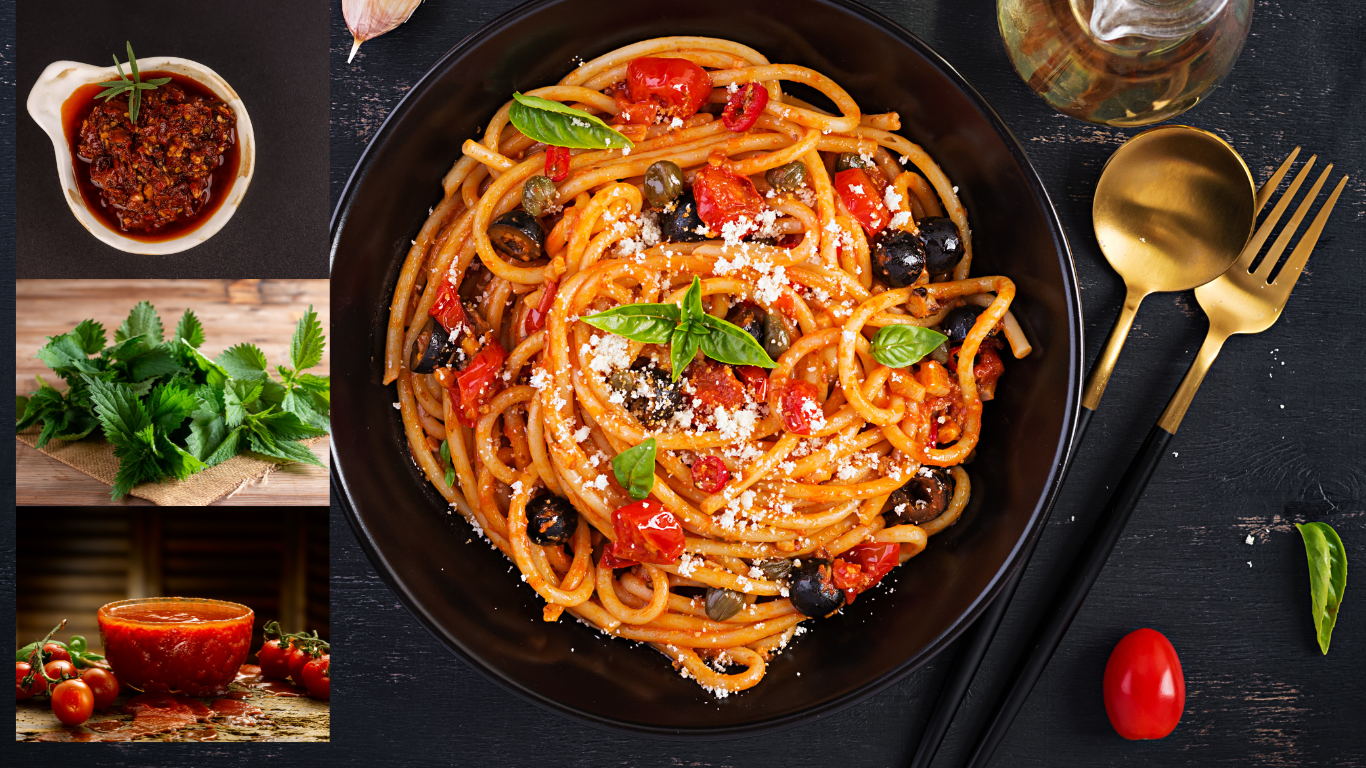Introduction.
Spaghetti alla Puttanesca is a dish that transcends mere sustenance; it captures the essence of Italian cuisine with its bold flavors, vibrant colors, and rich history. This classic pasta dish, characterized by its tangy tomato sauce, pungent olives, and zesty capers, tells a story of Italian culture, resourcefulness, and the beauty of simplicity. In this article, we will explore the origins of Spaghetti alla Puttanesca, its ingredients, preparation methods, variations, cultural significance, and more.
The Origins of Spaghetti alla Puttanesca.
The origins of Spaghetti alla Puttanesca are steeped in folklore and culinary lore. While the exact birthplace of this dish is debated, it is widely believed to have emerged in the mid 20th century in Naples, Italy. The term “puttanesca” is derived from the Italian word “puttana,” which translates to “prostitute.” This etymology has sparked much curiosity and speculation regarding the dish’s association with the world of sex work.
Theories Behind the Name.
Several theories attempt to explain the connection between the dish and its provocative name:
- Quick Meal for Workers: One theory posits that the dish was created by sex workers who needed to prepare a quick meal between clients. The accessibility of the ingredients meant that they could whip up a nourishing dish in no time.
- Flavorful and Irresistible: Another theory suggests that the dish’s bold flavors were meant to entice and attract patrons, much like the allure of the women it is named after.
- Culinary Resourcefulness: Some culinary historians argue that the name reflects the resourcefulness of those who lived in impoverished neighborhoods. The dish was made using leftover ingredients, creating a quick and flavorful meal that anyone could afford.
Regardless of its origin, Spaghetti alla Puttanesca has become a beloved staple of Italian cuisine, celebrated for its robust flavor and straightforward preparation.
Ingredients: Building the Flavor Profile.
The beauty of Spaghetti alla Puttanesca lies in its simplicity and the quality of its ingredients. Here’s a breakdown of the essential components that contribute to its distinctive taste:
1. Spaghetti.
The star of the dish, spaghetti, is a long, thin pasta that cooks quickly and pairs well with the sauce. While traditional recipes call for spaghetti, other pasta shapes like linguine or fettuccine can be used based on personal preference.
2. Tomatoes.
Tomatoes form the base of the sauce, providing acidity and richness. Canned San Marzano tomatoes are often recommended for their sweet flavor and low acidity, but fresh ripe tomatoes can also be used during the summer months.
3. Olives.
Black olives are a key ingredient, adding a briny depth to the sauce. Gaeta olives, which are small, dark, and slightly sweet, are traditionally used, but Kalamata olives are a popular alternative.
4. Capers.
Capers introduce a tangy and briny flavor that complements the other ingredients. These tiny flower buds are packed with flavor and are usually rinsed before being added to the sauce to remove excess salt.
5. Garlic.
Garlic is a fundamental element in Italian cooking, and in Spaghetti alla Puttanesca, it adds a fragrant aroma and depth of flavor. It is typically sautéed until golden before the other ingredients are introduced.
6. Red Pepper Flakes.
For those who enjoy a bit of heat, red pepper flakes are added to the sauce, giving it a spicy kick that balances the other flavors beautifully.
7. Olive Oil.
Extra virgin olive oil is the backbone of the sauce, providing richness and a fruity flavor. It is used to sauté the garlic and coat the pasta, enhancing the overall dish.
8. Parsley.
Fresh parsley is often used as a garnish, adding a pop of color and freshness to the dish. It also provides a subtle herbal note that complements the sauce.
Preparation: Cooking Spaghetti alla Puttanesca.
Creating Spaghetti alla Puttanesca is straightforward and can be accomplished in under 30 minutes, making it an ideal dish for busy weeknights. Here’s a step by step guide to preparing this iconic pasta dish.
Step 1: Cook the Spaghetti.
- Bring a large pot of salted water to a boil.
- Add the spaghetti and cook according to the package instructions until al dente.
- Reserve a cup of pasta water, then drain the spaghetti and set it aside.
Step 2: Prepare the Sauce.
- In a large skillet or sauté pan, heat 3-4 tablespoons of extra virgin olive oil over medium heat.
- Add 2-3 cloves of minced garlic and sauté until fragrant, about 1-2 minutes.
- Stir in 1-2 teaspoons of red pepper flakes, adjusting the amount based on your heat preference.
- Add the canned tomatoes (crushed or whole) along with a pinch of salt and pepper. If using whole tomatoes, break them up with a spoon.
- Stir in 1/2 cup of pitted and chopped black olives and 2 tablespoons of rinsed capers.
- Simmer the sauce for about 10-15 minutes, stirring occasionally, until it thickens slightly.
Step 3: Combine Pasta and Sauce.
- Add the drained spaghetti to the skillet with the sauce, tossing to combine.
- If the sauce is too thick, gradually add some reserved pasta water until you reach the desired consistency.
- Taste and adjust the seasoning if needed.
Step 4: Serve.
- Plate the spaghetti and garnish with freshly chopped parsley and grated Parmesan cheese, if desired.
- Drizzle with a bit more olive oil for added richness.
- Serve immediately, accompanied by crusty bread and a side salad.
Variations of Spaghetti alla Puttanesca.
While traditional Spaghetti alla Puttanesca is beloved for its classic flavors, many chefs and home cooks have experimented with variations of this iconic dish. Here are some creative twists on the original recipe:
1. Seafood Puttanesca.
Incorporating seafood, such as shrimp or anchovies, adds a delightful umami flavor to the sauce. The seafood can be sautéed with the garlic before adding the tomatoes, creating a rich, ocean-inspired dish.
2. Vegetarian Puttanesca.
For a vegetarian version, simply omit any seafood ingredients and load up on additional vegetables. Sautéed zucchini, bell peppers, or mushrooms can enhance the texture and flavor of the dish.
3. Whole Wheat or Gluten Free Pasta.
For those looking for a healthier alternative, whole wheat or gluten-free pasta can be used without compromising the dish’s flavor. The nutty flavor of whole wheat pasta complements the sauce beautifully.
4. Spicy Puttanesca.
For spice lovers, amp up the heat by adding extra red pepper flakes or incorporating sliced fresh chili peppers into the sauce. This variation brings an exciting level of heat to the traditional recipe.
5. Creamy Puttanesca.
For a richer, creamier sauce, consider adding a splash of heavy cream or a dollop of mascarpone cheese at the end of cooking. This creates a luxurious texture while still maintaining the essence of the original dish.
Cultural Significance of Spaghetti alla Puttanesca.
Spaghetti alla Puttanesca is more than just a dish; it is a representation of Italian culture and the country’s culinary heritage. Its roots in Naples reflect the region’s history of resourcefulness, where simple yet flavorful ingredients come together to create a satisfying meal.
A Symbol of Italian Home Cooking.
In Italy, home cooked meals hold immense value, often bringing families together around the dining table. Spaghetti alla Puttanesca is a dish that embodies this philosophy, as it is easy to prepare and can be enjoyed by all generations.
The Mediterranean Diet.
Spaghetti alla Puttanesca also exemplifies the principles of the Mediterranean diet, which emphasizes fresh, whole ingredients, healthy fats, and balanced meals. The dish’s focus on vegetables, olive oil, and lean protein aligns with the dietary guidelines praised for their health benefits.
Culinary Tourism.
As Italian cuisine gains popularity worldwide, dishes like Spaghetti alla Puttanesca have become synonymous with Italian culinary traditions. Tourists flock to Italy to experience authentic pasta dishes, and Spaghetti alla Puttanesca is often at the forefront of their gastronomic adventures.
Conclusion.
Spaghetti alla Puttanesca is a dish that tells a story a narrative of flavor, history, and culture that has captivated food lovers for generations. Whether enjoyed in a bustling trattoria in Naples or prepared at home on a cozy weeknight, this iconic pasta dish continues to bring joy and satisfaction to tables around the world.
With its simple yet bold ingredients, Spaghetti alla Puttanesca exemplifies the beauty of Italian cooking, where each bite is a reminder of the rich tapestry of flavors and traditions that define this beloved cuisine. So the next time you find yourself craving a quick and delicious meal, consider reaching for the pasta and bringing the timeless taste of Spaghetti alla Puttanesca to your plate.
Questions and Answers.
1. What is the history behind Spaghetti alla Puttanesca?
- Spaghetti alla Puttanesca is thought to have originated in Naples, Italy, around the mid 20th century. The name comes from the Italian word “puttana,” meaning “prostitute,” and there are several intriguing theories about how the dish got its name.
2. What key ingredients are used in Spaghetti alla Puttanesca?
- The essential ingredients for Spaghetti alla Puttanesca include spaghetti, tomatoes (either canned or fresh), black olives, capers, garlic, red pepper flakes, and extra virgin olive oil.
3. How can I create a vegetarian version of Spaghetti alla Puttanesca?
- To prepare a vegetarian Spaghetti alla Puttanesca, simply leave out any seafood components. You can enhance the dish by adding extra vegetables such as zucchini, bell peppers, or mushrooms for added flavor and texture.
4. Can I substitute other types of pasta in this recipe?
- Absolutely! While spaghetti is the classic choice, you can use various pasta shapes like linguine, fettuccine, or even whole wheat or gluten free pasta, as they all work well with the Puttanesca sauce.
5. What is the best way to store and reheat leftover Spaghetti alla Puttanesca?
- To store leftovers, transfer the pasta to an airtight container and refrigerate for up to three days. When reheating, add a little water or olive oil to the pasta to prevent drying out, and warm it gently in a skillet or microwave until heated through.

